Ever wondered how to make your home’s first impression truly unforgettable? Single-floor front elevation designs have become incredibly popular because they effortlessly blend practicality with stunning curb appeal, making homes feel welcoming, cozy, and stylish—all without the complexity of multiple stories. Their simplicity offers a clean, charming look that can be easily customized to reflect your personality and taste, whether you love modern minimalism or rustic warmth.
In this article, you’ll find a treasure trove of inspiration and practical ideas to elevate your home’s exterior. From warm color palettes and inviting porches to charming details like decorative lighting and natural accents, we cover a variety of design tips that suit different styles and budgets. Get ready to discover creative ways to craft a warm, welcoming front facade that not only impresses guests but also makes every day feel like coming home.
1. Use of Warm-toned Exterior Paints for Instant Curb Appeal
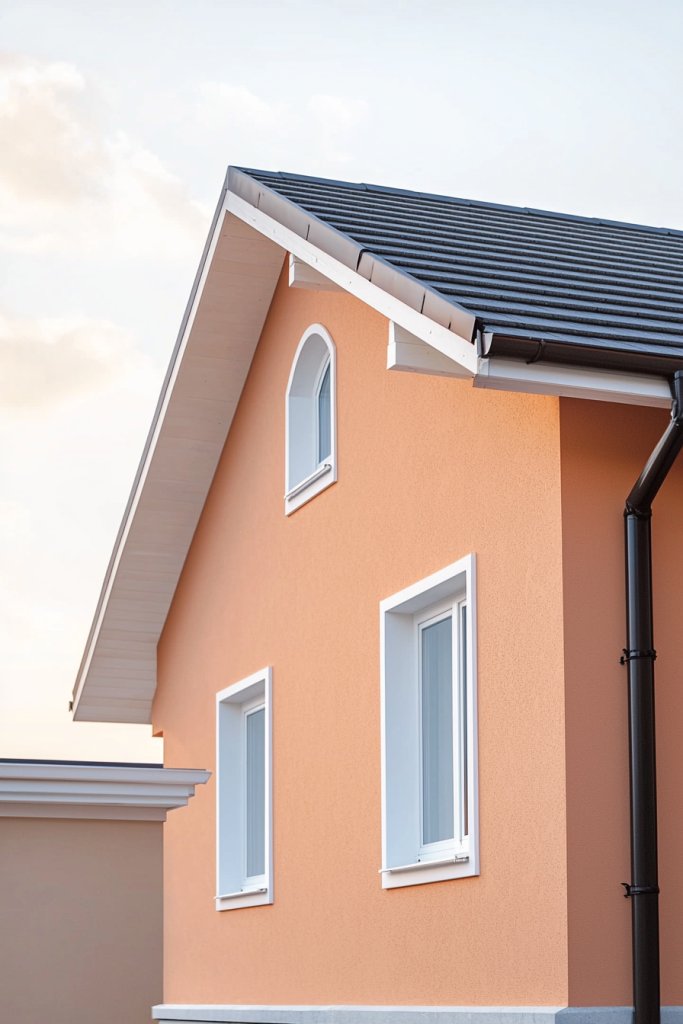
First impressions count, and choosing warm-toned exterior paints instantly makes your home feel inviting and cozy. These hues evoke feelings of comfort and friendliness, transforming a simple house into a welcoming haven.
Warm colors like terracotta, soft peach, warm beige, or buttery yellow add personality while blending seamlessly with natural surroundings. Imagine a house with a soft, creamy beige facade accented by a deep terracotta door and warm honey shutters.
The walls glow subtly under natural sunlight, creating a gentle, inviting atmosphere. Complementary details like a white trim or stone accents enhance the warmth, making the exterior appear both vibrant and harmonious.
The overall effect feels comforting, as if inviting guests to step inside and relax. To recreate this look, start by selecting high-quality exterior paints in warm shades such as terracotta or caramel.
Prep your walls by cleaning and priming them for smooth application. Use brushes or rollers suited for exterior surfaces, and consider adding a protective sealant for durability. Pair your paint choice with natural materials like wood or stone for trim and accents, and keep the color palette consistent for a cohesive, welcoming appearance.
2. Incorporating Cozy Porch Seating with Plush Cushions
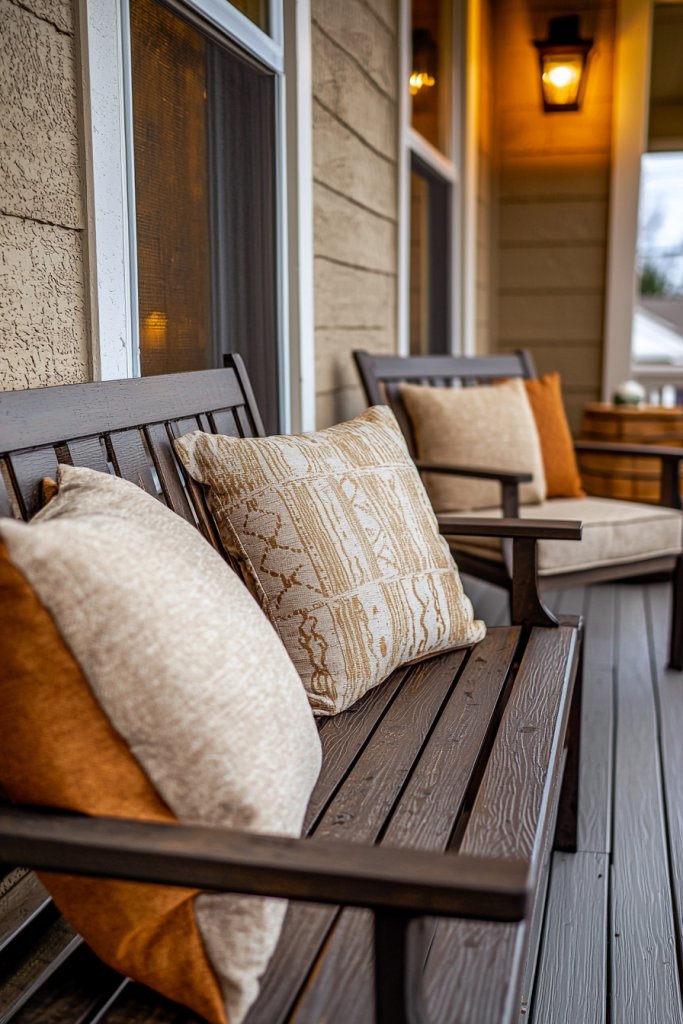
A cozy porch with plush cushions instantly signals hospitality and comfort, transforming your entrance into a relaxing retreat. This setup encourages lingering, making visitors feel at home from the moment they arrive.
Soft, inviting seating paired with textured cushions creates an atmosphere of warmth and ease. Picture a quaint front porch with a rustic wooden bench or a pair of armchairs dressed in weather-resistant fabric.
Adorn them with plush cushions in warm tones—think deep rust, creamy beige, or soft terracotta—featuring textures like chunky knits or velvets. Add a cozy throw blanket draped over the armrest and perhaps a small side table holding a lantern or a fragrant candle.
The tactile mix of fabrics invites touch, while the inviting arrangement suggests a space for relaxation and conversation. To bring this idea to life, choose weatherproof cushions made from durable, fade-resistant fabrics like polyester or acrylic.
Pick colors and textures that complement your home’s exterior palette—warm hues and soft textiles work best. Arrange your seating in a way that encourages conversation, and add accessories like a soft throw or decorative pillows for extra comfort. Keep the space tidy and inviting with a simple outdoor rug or mat underneath to define the area.
3. Adding a Welcoming Pathway with Decorative Pavers or Stones
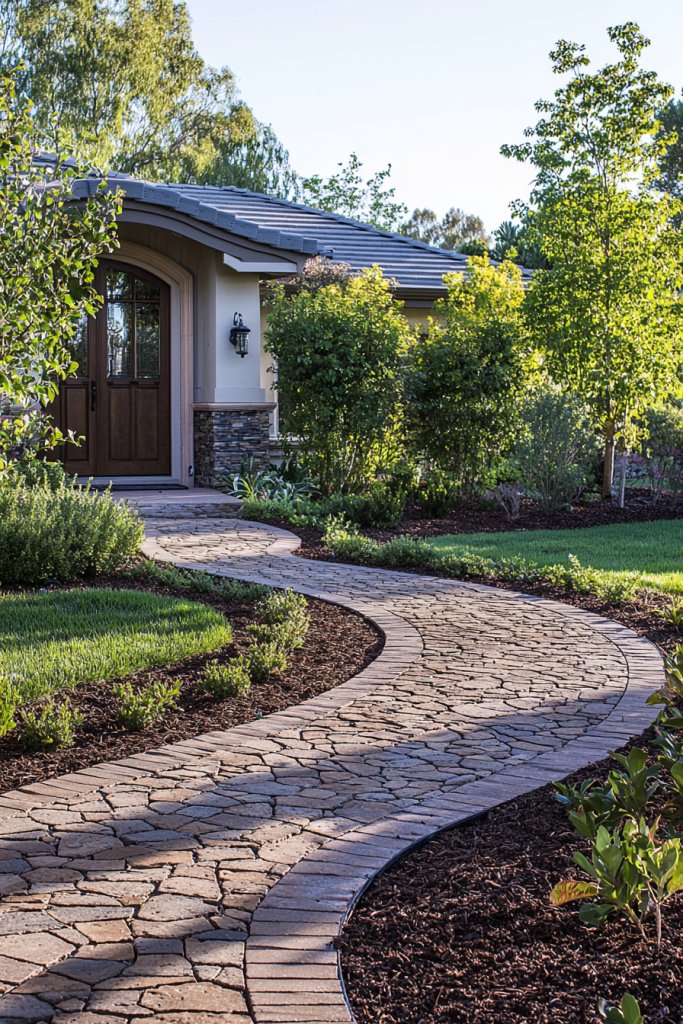
A charming pathway guides guests directly to your front door while setting the tone for the home’s style. Decorative pavers or stones add visual interest and create a welcoming, maintained appearance that invites exploration.
Their textures and patterns can complement the overall design, making the entrance feel intentional and warm. Visualize a winding pathway made from irregular natural stones or geometric patterned pavers in earthy tones like terracotta, rust, or warm gray.
The stones are laid out with precision, bordered by low-growing plants, gravel, or mulch that adds texture. Soft landscape lighting along the edges enhances the pathway’s appeal at dusk, casting a gentle glow that beckons visitors.
The combination of textures, colors, and lighting creates an inviting, cohesive entrance that feels both rustic and refined. To implement, select pavers or stones suitable for outdoor use, considering durability and aesthetic preference.
Prepare the ground by leveling and adding a base layer of gravel or sand. Lay the pavers or stones carefully, maintaining even spacing and pattern alignment.
Finish by edging the pathway with low plants, mulch, or decorative gravel, and install outdoor lighting to enhance safety and ambiance. This simple addition makes your entrance both functional and charming.
4. Installing Stylish Wall-mounted Lanterns or Sconces
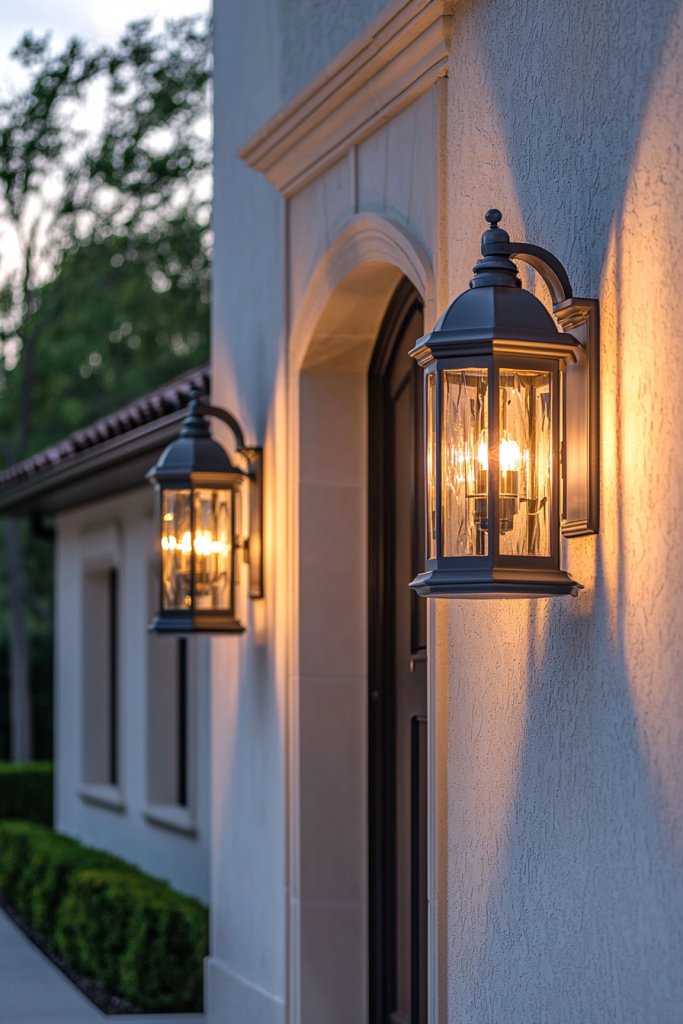
Lighting plays a pivotal role in creating an inviting atmosphere, and wall-mounted lanterns or sconces add both style and functionality to your front elevation. These fixtures highlight architectural details, add warmth, and improve safety, especially during evening hours.
Envision sleek black or antique brass lanterns flanking your front door, their warm glow illuminating the entryway. The soft light accentuates the architectural features, such as a charming front door or decorative trim, while casting a welcoming ambiance.
For a rustic look, go for lanterns with metal cage designs, or opt for modern minimalism with streamlined fixtures. The warm light, combined with the fixture’s style, sets a cozy, inviting tone for visitors.
To install, choose fixtures that match your home’s overall style and provide adequate illumination. Ensure they are rated for outdoor use and are wired safely according to local codes.
Mount the lanterns at eye level or slightly above the door frame for maximum impact. Use LED bulbs for energy efficiency and longevity. Positioning stylish sconces on either side of the door not only enhances curb appeal but also creates a warm, inviting glow that beckons guests inside.
5. Featuring a Charming Front Door with Elegant Hardware
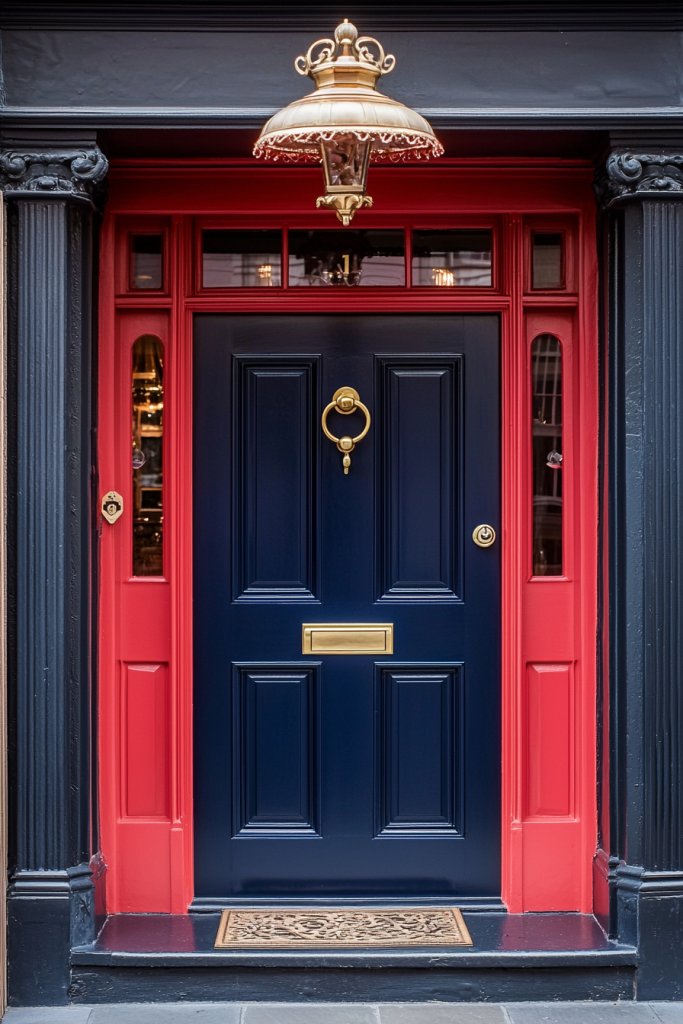
A charming front door with elegant hardware instantly elevates your home’s curb appeal and invites visitors to step into a warm, welcoming space. The right door hardware can transform a simple entrance into a statement piece that reflects your personal style and hospitality.
Imagine a beautifully crafted wooden door painted in a soft, muted hue like dove gray or pastel blue, accented with brass or matte black hardware—such as a sleek handle, a decorative knocker, and a matching doorbell. The hardware’s intricate detailing adds a touch of sophistication, while the door itself may feature subtle paneling or glass inserts with frosted or stained glass for a hint of color.
Flanking the door, you might see charming elements like a vintage-style door handle or a decorative kickplate, complemented by a fresh wreath or a stylish door hanger. The overall look exudes elegance, warmth, and a sense of crafted charm that makes your home feel inviting from the moment guests arrive.
To recreate this look, start with a sturdy, beautiful front door made of wood or fiberglass, choosing a color that complements your exterior palette. Select high-quality hardware—brass, black matte, or antique bronze—available at most hardware stores or online, and consider adding a decorative handle, knocker, or handle set for extra flair.
Installing the hardware is straightforward with basic tools like a screwdriver and drill; many options come with detailed instructions. Finish the look with a charming doormat, a seasonal wreath, or a vintage-style lantern nearby to enhance the inviting vibe. With a few simple upgrades, your front door can become a true showstopper that warmly welcomes everyone inside.
6. Enhancing the Entrance with a Bright, Eye-catching Doormat
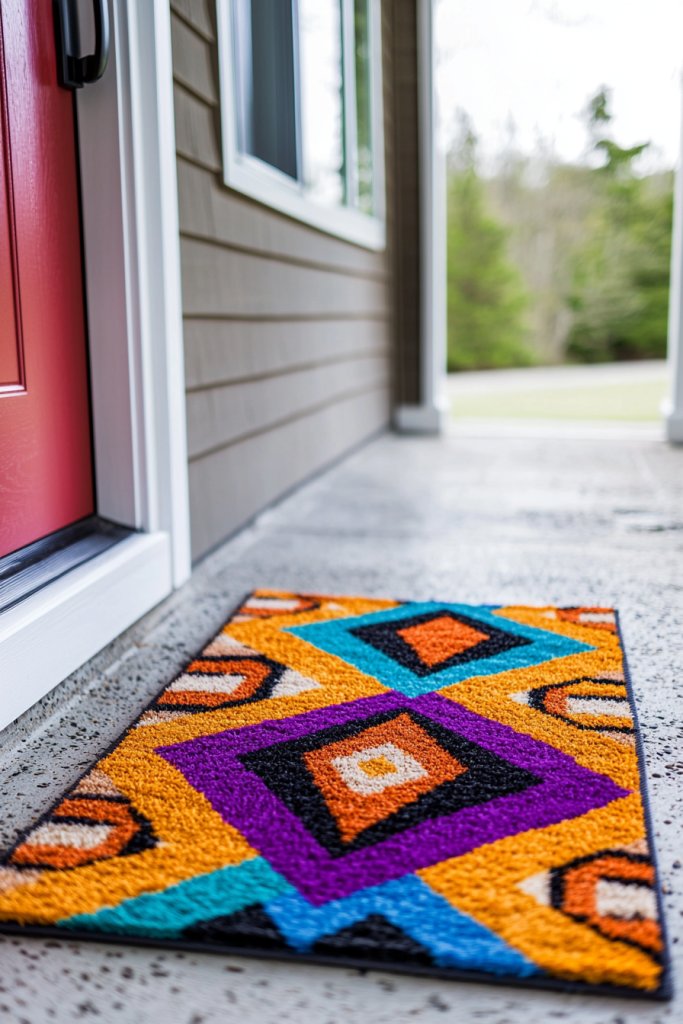
A vibrant doormat is a simple yet powerful way to make your front entrance feel warm and inviting, setting the tone for the entire home. It’s an easy upgrade that instantly adds personality, personality, and charm, making visitors feel welcome from the moment they arrive.
Imagine a cheerful, colorful doormat featuring bold geometric patterns or playful floral motifs in shades like sunny yellow, cheerful red, or calming teal. The texture of a coir or rubber mat provides a tactile contrast to the smooth porch surface, while the bright colors catch the eye and lift the mood.
It’s a focal point that combines functionality—keeping dirt at bay—with visual appeal. When paired with a clean, well-maintained entryway, this small element creates a cozy, approachable atmosphere that resonates with warmth and friendliness.
To incorporate this idea, choose a doormat that complements your overall exterior color scheme—perhaps a bright hue that contrasts with or echoes your house’s exterior. Simply measure your doorstep to pick a size that fits comfortably without overwhelming the space.
Place it directly in front of your door, and for added charm, consider layering with a smaller, patterned rug or adding a decorative wreath nearby. Opt for durable materials like coir or rubber, which withstand the elements, and keep it clean and vibrant with regular brushing or rinsing. This small touch makes a big difference in creating a welcoming first impression.
7. Framing the Entrance with Symmetrical Window Designs
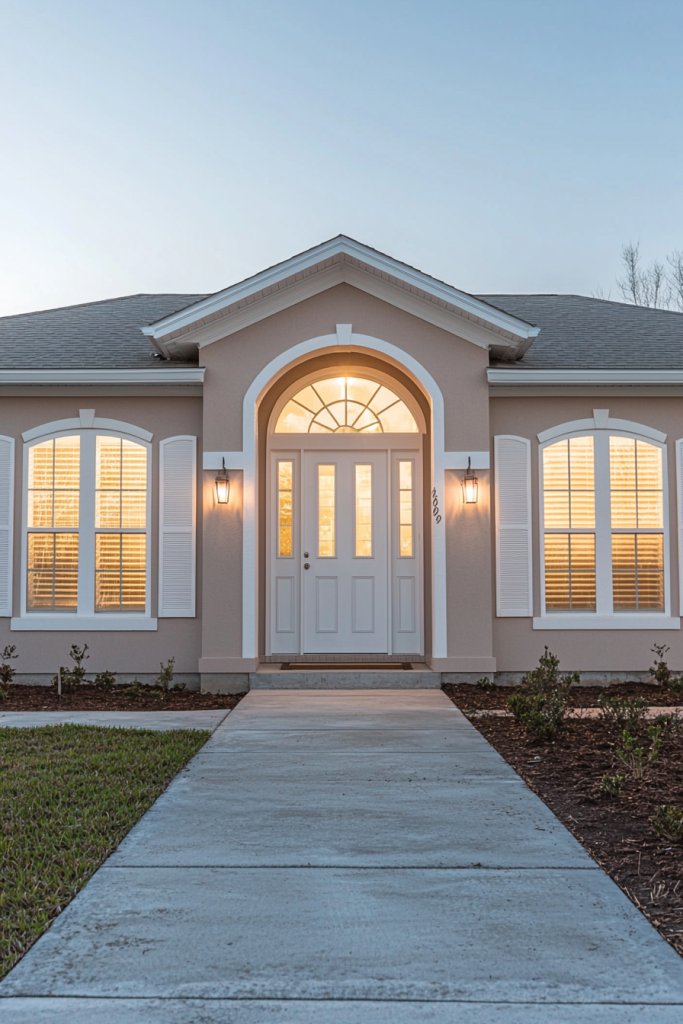
Symmetrical window arrangements around your front door create a balanced, harmonious look that exudes inviting elegance and enhances curb appeal. This classic design approach emphasizes order and symmetry, making your home feel warm, approachable, and thoughtfully designed.
Visualize two evenly spaced windows flanking your front door, perhaps with matching shutters or decorative trim painted in coordinating colors—soft whites, warm beiges, or even contrasting dark tones for a striking effect. The glass panes might feature grid patterns or simple clear glass, allowing natural light to flood the interior while framing the entryway with crisp, clean lines.
The symmetry offers a sense of stability and charm, making your home look well-maintained and welcoming. Additional details like flower boxes beneath the windows or subtle molding can further enhance this balanced look, adding a touch of character and personality.
To achieve this, start by selecting window sizes that proportionally suit your home’s facade. Ensure the windows are placed at equal heights and distances from the door for perfect symmetry.
Consider adding shutters, decorative trim, or even subtle lighting fixtures above each window to highlight their presence at night. If existing windows aren’t symmetrical, you can create the illusion by adding matching side panels or installing new windows that mirror each other’s size and style.
Keep the color palette consistent with your exterior walls, and maintain regular cleaning for a polished, inviting appearance. This approach instantly elevates your home’s curb appeal with timeless elegance.
8. Incorporating Natural Wood Accents for a Rustic Feel
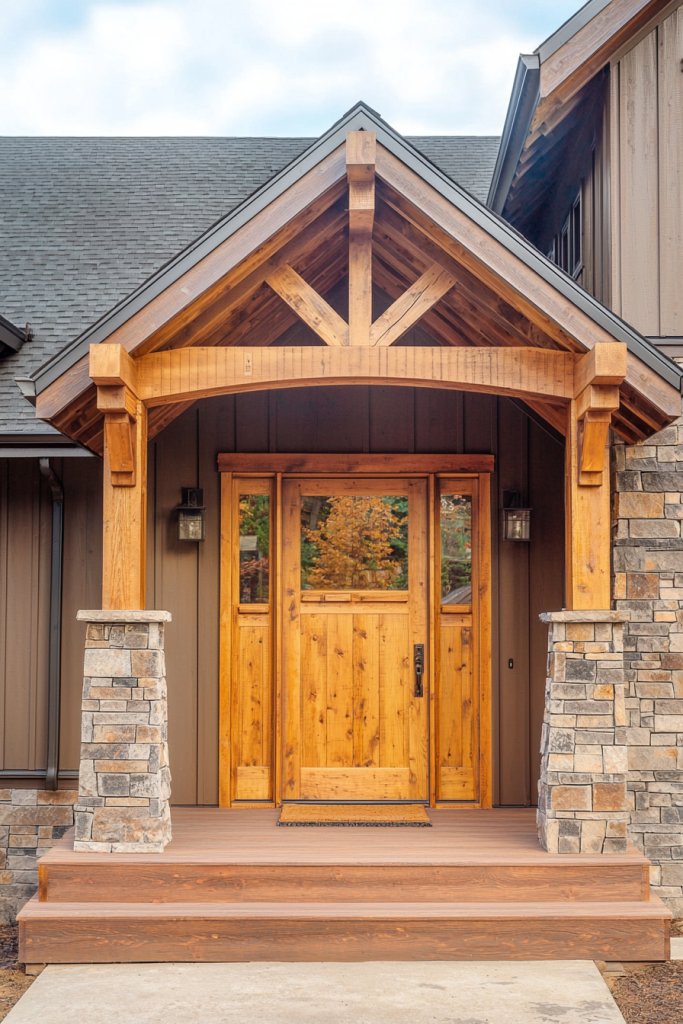
Adding natural wood accents to your front elevation introduces warmth, texture, and a cozy rustic charm that feels both inviting and timeless. Wood elements soften the exterior’s overall look and create a connection to nature, making your home seem more welcoming and grounded.
Picture a front porch with a wooden pergola, or perhaps a decorative wooden panel or cladding on parts of the facade. The wood could be stained in warm honey, deep walnut, or weathered gray, depending on your preferred style.
You might also incorporate wooden window shutters, a rustic signboard, or a wooden bench near the entrance. The tactile quality of wood adds visual depth, while its earthy scent enhances the sensory experience.
The combination of natural textures with your house’s exterior paints creates a harmonious, warm aesthetic that beckons visitors inside. To implement this look, source high-quality, treated wooden planks or panels suitable for outdoor use.
For a DIY project, you can install wooden shutters or a small porch canopy using basic tools and weather-resistant wood stain or sealant. For a more polished finish, consider hiring a professional to craft custom wood accents that integrate seamlessly with your home’s architecture.
Keep the wood well-maintained with periodic sealing or staining to preserve its beauty and durability. Whether used minimally or extensively, natural wood accents instantly boost your home’s rustic charm and create an inviting, warm exterior that feels personal and cozy.
9. Using Soft, Ambient Outdoor Lighting to Create Inviting Atmosphere
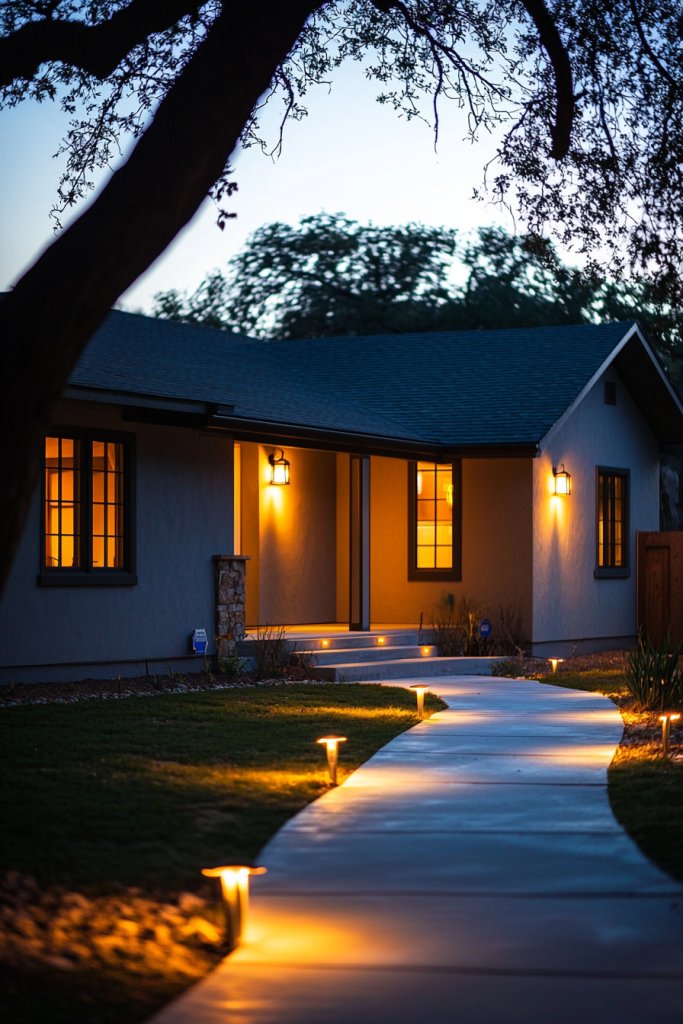
Soft outdoor lighting transforms your front elevation from ordinary to enchanting, creating an inviting ambiance that beckons guests and enhances safety during evening hours. Thoughtfully placed lighting fixtures highlight architectural features and set a warm, welcoming tone.
Imagine warm-white LED string lights draped along the porch or around trees, casting a gentle glow that flickers softly. Stylish wall-mounted lanterns or sconces flank your front door, emitting a cozy illumination that invites visitors inside.
Pathway lights with diffused bulbs or solar-powered stake lights line the walkway, guiding guests while adding a subtle sparkle. The combination of layered lighting—ambient, accent, and task—creates depth and visual interest, making your exterior look warm and lively after sunset.
The gentle glow also enhances the textures of your facade and landscaping, making your home feel safe, inviting, and relaxing. Getting started is simple: choose weatherproof fixtures with warm-toned bulbs (2700K to 3000K).
Install sconces on either side of the door for symmetry, and add pathway lights along the walkway or garden beds. Use solar-powered or low-voltage options for energy efficiency and ease of installation.
Position the lights to avoid harsh shadows or overly bright spots, focusing instead on creating a soft, even glow. With minimal effort and a few well-chosen fixtures, you can craft an outdoor environment that feels like a welcoming haven, day or night.
10. Installing a Small Front Garden with Decorative Gravel and Mulch

A thoughtfully designed small front garden with decorative gravel and mulch instantly elevates your home’s curb appeal while providing a low-maintenance, inviting landscape feature. It creates a visual buffer between your home and the street, adding texture and color.
Visualize a neat border of smooth, multicolored gravel interspersed with stepping stones or a compact mulched bed filled with ornamental plants, shrubs, or flowering perennials. Using decorative gravel in shades like white, gray, or tan adds brightness and modernity, while the mulch provides a warm, finished appearance.
Incorporate small, drought-tolerant plants such as succulents, lavender, or ornamental grasses to add greenery without requiring extensive upkeep. The combination of gravel and mulch creates a tidy, organized look that feels welcoming and well-cared-for, framing your entrance with subtle elegance and a touch of nature.
To create this garden, start by marking out the desired area with garden edging or low borders. Lay down a weed barrier fabric, then spread your chosen decorative gravel evenly, filling gaps with additional gravel or small stones.
For mulched beds, apply a layer of bark mulch or wood chips over the soil, then plant your selected greenery. Use a mix of plants with varying heights and textures for visual interest.
Regularly rake and refresh the gravel or mulch to maintain its appearance, and consider adding solar garden lights or small sculptures for extra charm. This simple, stylish garden enhances your home’s first impression without requiring extensive gardening skills or ongoing maintenance.
11. Adding Architectural Details like Arches or Columns for Character

Adding architectural details such as arches or columns instantly elevates the charm and character of a single-floor front elevation, making your home stand out with timeless appeal. These elements create visual interest by introducing classical or Mediterranean influences that evoke warmth and sophistication.
They also serve as focal points that draw the eye toward the entrance, making visitors feel welcomed and intrigued before they even step inside. Imagine a smooth, curved archway framing the front door, painted in a soft, warm beige that complements the exterior walls.
Flanking the entrance are slender, elegant columns with textured stone or faux finishes, giving a sense of grandeur while maintaining a cozy, inviting atmosphere. The overall effect is a balanced blend of traditional elegance and rustic charm, with warm-toned accents like terracotta tiles or wooden trim enhancing the welcoming vibe.
The textures and curves add depth to the facade, making it both visually appealing and architecturally expressive. To implement this idea, start by choosing a style that matches your home’s overall aesthetic—be it classical, rustic, or contemporary.
For arches, you can opt for pre-made kits or work with a mason to craft custom curves using concrete or stone veneer. Columns can be simple or ornate, made from materials like wood, concrete, or fiberglass, depending on your budget.
For a DIY approach, consider lightweight faux columns wrapped in textured finishes, and add decorative capitals or bases for extra detail. Finish with warm paint tones and complementary lighting to highlight these features at night.
12. Incorporating a Porch Swing or Hammock for a Cozy Touch
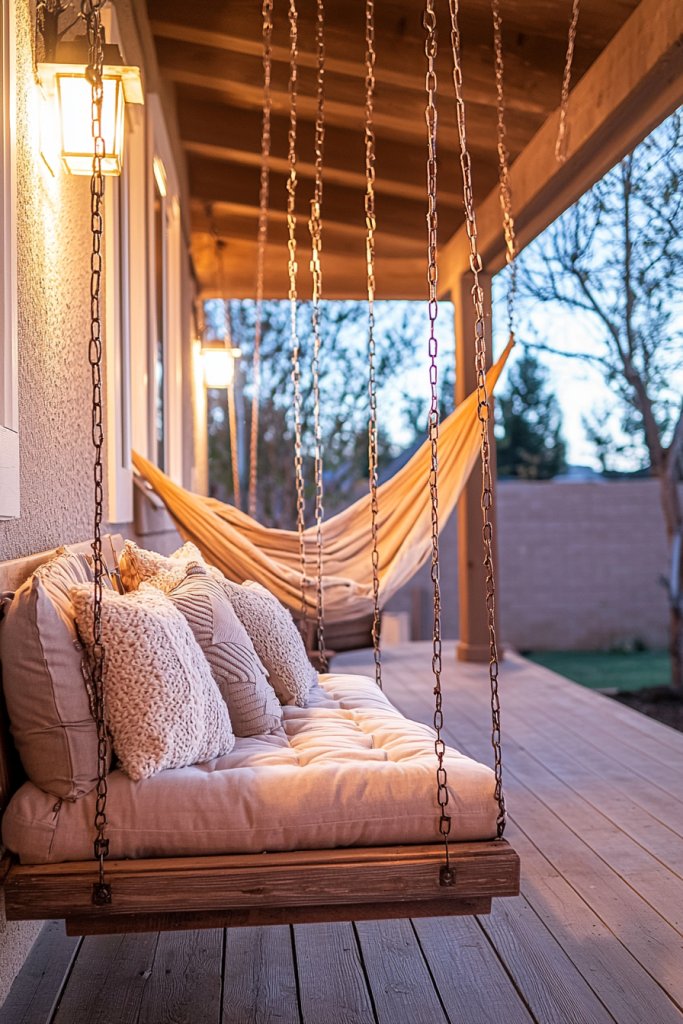
A porch swing or hammock instantly adds a relaxed and cozy vibe to your single-floor home’s exterior, inviting family and guests to unwind and enjoy the outdoors. These elements evoke feelings of comfort and leisure, transforming your front porch into a personal retreat.
Plus, they serve as stylish, functional decor that enhances the overall warmth and friendliness of your home’s facade. Picture a sturdy wooden porch swing painted in a soft pastel or neutral tone, suspended from a pergola or ceiling with wrought iron hooks.
Cushions in plush fabrics like linen or cotton, in colors such as cream, blush, or sage, invite cozy seating. Alternatively, a woven hammock in natural fiber, like jute or cotton, strung between two sturdy posts or trees, adds a breezy, laid-back charm.
Surround the seating with textured throws — a chunky knit blanket or a soft, patterned cushion — to enhance the tactile appeal. The scent of fresh air and the gentle sway evoke calm and relaxation, perfect for lazy Sunday mornings.
To bring this idea to life, first ensure your porch or outdoor space can support the weight of a swing or hammock. Use weather-resistant materials such as cedar or treated wood for the swing frame, or opt for durable, outdoor-specific fabrics for cushions.
For hammocks, choose high-quality, UV-resistant fabrics and sturdy hardware. Hang the swing from a solid beam or ceiling mount, making sure to follow safety guidelines for weight capacity.
For the hammock, secure it between two stable posts or trees, and add a small side table or outdoor rug underneath to complete the cozy setup. Incorporate soft lighting, like fairy lights or lanterns, to make the space inviting even after dark.
13. Using Textured Wall Cladding for Visual Interest

Textured wall cladding breathes new life into a single-floor front elevation by adding depth, dimension, and tactile appeal. This technique transforms a plain facade into an engaging visual statement, creating a warm, inviting atmosphere that beckons visitors with its rich textures and contrasting finishes.
It’s the perfect way to add character without overwhelming the overall design. Visualize a facade where sections of the wall are clad in rough-cut stone or brick veneer, creating a rustic yet refined look.
Alternatively, textured plaster or stucco with a subtle pebble or sand finish provides a soft, matte surface that catches light beautifully. These textures can be applied selectively around the entrance or as an accent wall, balanced with smooth painted sections for harmony.
Warm hues like terracotta, sandy beige, or earthy browns enhance the natural feel and evoke a welcoming ambiance. The tactile quality invites not only visual appreciation but also a sense of coziness and authenticity.
Implementing textured wall cladding involves selecting the right materials based on your style and budget. For an easy DIY project, consider peel-and-stick stone veneer or faux brick panels that attach directly to existing walls with adhesive.
For more durable and authentic finishes, hire a professional to apply textured plaster or stucco. When choosing colors, stick to warm, earthy shades that complement your overall exterior palette. Finish the look with appropriate lighting—such as wall-mounted fixtures—to highlight the textures and create inviting shadows after sunset.
14. Installing a Stylish and Functional Front Door Canopy

A front door canopy not only protects your entrance from rain and sun but also adds a distinctive architectural feature that enhances your home’s curb appeal. A well-designed canopy creates a welcoming focal point, framing the entrance beautifully while providing practical shelter.
When styled thoughtfully, it can elevate the entire facade with a touch of elegance and warmth. Picture a canopy crafted from wrought iron or wood, with a gently curved or straight edge profile, painted in a complementary color like deep bronze or warm brown.
The underside could feature decorative brackets or corbels, adding intricate detail. Covering the top is a weather-resistant material—such as polycarbonate or tile—that allows natural light to filter through while shielding the doorway.
Accentuate the design with warm-toned lighting fixtures or hanging lanterns, casting a cozy glow over the entrance. Surround the area with warm-colored paint, decorative tiles, or stone accents to create a harmonious, inviting entryway that welcomes visitors with style and functionality.
To install a front door canopy, start by measuring your door width and choosing a size that provides ample coverage without overwhelming the space. Select durable, weatherproof materials suitable for your climate—wood with sealant or metal with rust-resistant coating.
Mount sturdy brackets or supports directly onto the wall, ensuring they are anchored into studs or suitable anchors for safety. Finish by attaching the canopy, sealing edges against the weather, and adding lighting fixtures for nighttime illumination. Incorporate warm hues in nearby trim or wall paint to tie the canopy into your exterior design seamlessly.
15. Adding Warm-colored House Numbers and Signage
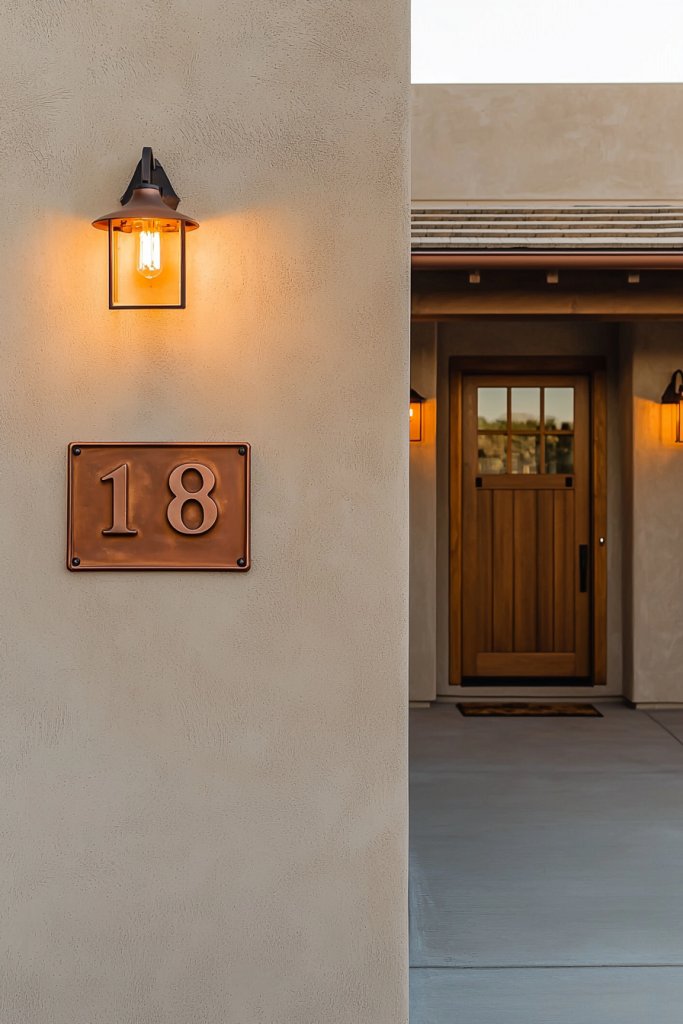
Warm-colored house numbers and signage are subtle yet impactful details that create instant visual warmth and easy identification for your home’s front elevation. These accents serve both practical and aesthetic purposes, guiding visitors clearly while enhancing the welcoming charm of your exterior.
Choosing the right font, finish, and placement can make your home appear more inviting and well-designed. Imagine large, bold house numbers in a matte brass or copper finish, mounted on a textured stone or painted wall in shades of soft cream or warm taupe.
The numbers gleam subtly in the sunlight, adding a touch of elegance. Complementary signage—such as a custom nameplate or welcome sign—features warm-toned wood or metal with engraved or painted lettering, harmonizing with the overall color palette.
The signage could be framed with decorative trim or placed on a contrasting background for maximum visibility. These details subtly communicate hospitality and style, making your home feel approachable and refined.
To incorporate this idea, choose house numbers made from durable materials like brass, copper, or painted metal, ensuring they withstand weather conditions. Position them at eye level near the door or on a prominent wall, using anchors and spacers for a flush, clean look.
For signage, select weather-resistant wood or metal with a warm finish, opting for fonts that are clear and legible. Use outdoor-grade adhesive or mounting hardware to secure signs firmly. Finish by lighting the numbers and signage with subtle accent lights or wall-mounted fixtures to ensure visibility at night and to add an inviting glow to your home’s exterior.
16. Incorporating Classic or Modern Pergolas with Drapes or Curtains
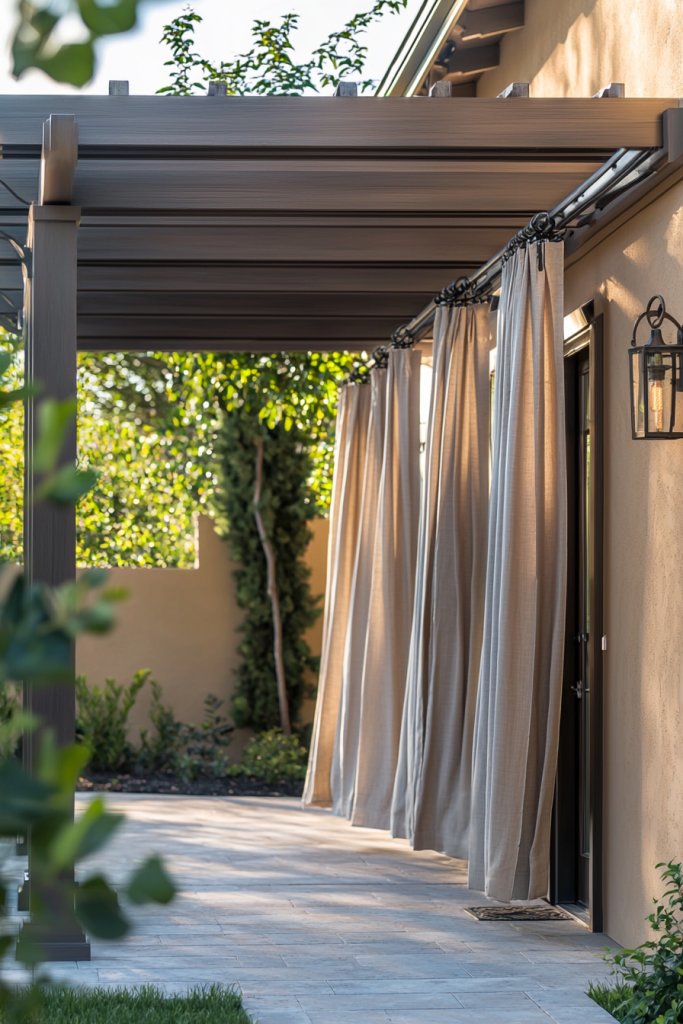
Adding a pergola with flowing drapes or curtains instantly elevates your home’s exterior, creating a charming and inviting entrance that beckons visitors. It’s a stylish way to define your front porch or walkway while adding a sense of privacy and coziness.
Whether you prefer a sleek modern pergola with clean lines or a more rustic, classic structure, incorporating fabric elements softens the architecture and introduces a welcoming ambiance. Imagine a beautifully crafted wooden pergola with a gentle arch, draped with lightweight, sheer curtains in soft beige or blush pink that flutter gently in the breeze.
The structure is complemented by hanging string lights or lanterns, enhancing the ambiance at dusk. The curtains can be tied back during the day to reveal lush potted plants or a cozy seating area underneath, making the space feel both functional and decorative.
The overall effect is a blend of elegance and comfort, perfect for outdoor gatherings or quiet mornings. To implement this look, start by choosing a pergola style that suits your home’s architecture—wooden for rustic charm or metal for a modern twist.
Install sturdy posts and a crossbeam framework, then add fabric curtains made of weather-resistant materials like polyester or acrylic for durability. Hang the curtains from hooks or a tension wire, and finish with decorative accessories like tiebacks or curtain rings. For added charm, incorporate outdoor string lights or hanging planters to create a warm, inviting atmosphere.
17. Using Decorative Wall Panels or Cladding to Add Depth
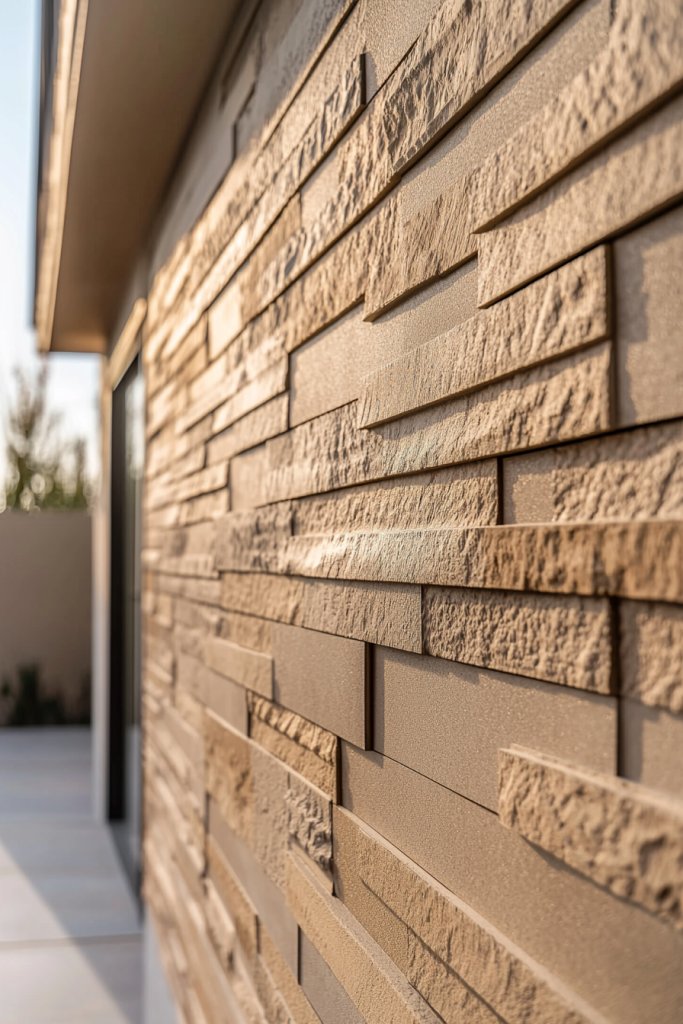
Decorative wall panels or cladding are an excellent way to bring texture and visual interest to your home’s facade, making a single-floor elevation feel layered and sophisticated. They serve as a focal point that adds depth and character, transforming a plain exterior into a stunning architectural feature.
From wood or stone to metal or textured composites, these panels offer endless creative possibilities. Visualize a smooth plastered facade accented by vertical wooden slats or textured stone veneer arranged in an alternating pattern.
The contrast between the materials creates shadows and highlights that change with the sunlight, giving the exterior a dynamic, lively feel. You might also consider patterned cladding with geometric shapes or embossed metal panels that catch the light, adding modern flair.
These textures can be incorporated around the entrance or along the entire frontage to create a balanced, captivating look. To implement, select panels or cladding materials suited to your climate and style—options include wooden battens, stone veneer, metal sheets, or high-pressure laminate for easier installation.
Prepare a clean, even surface, then attach the panels securely using appropriate fasteners. Consider combining different textures for a layered effect, and finish with weatherproof paint or sealant for longevity. This approach elevates your home’s curb appeal with minimal structural changes.
18. Integrating a Small Water Feature or Fountain for Tranquility

A small water feature or fountain near the entrance infuses your home with tranquility and a soothing visual element that welcomes guests with a sense of calm. The gentle sound of flowing water creates a peaceful atmosphere, making your exterior space feel more inviting and serene.
This feature also adds a touch of luxury and elegance to a single-story front elevation. Picture a compact, freestanding fountain crafted from natural stone or ceramic, positioned beside the pathway or near the porch.
Water gently cascades over textured surfaces, accompanied by the subtle scent of fresh water and the gentle hum of the pump. Surrounding the fountain with decorative gravel, pebbles, or lush greenery enhances the natural vibe.
Soft outdoor lighting highlights the water feature at night, providing a magical glow that draws the eye and invites relaxation. To create this feature, select a fountain design that fits your space—consider options made of stone, ceramic, or resin.
Purchase a small pump, and set the fountain on a level base, ensuring proper drainage and electrical safety. Surround it with decorative stones or planters filled with low-maintenance plants like succulents or ornamental grasses. Regular cleaning and pump maintenance will keep the water clear and the feature functioning beautifully for years to come.
19. Choosing Complementary Color Schemes for External Details
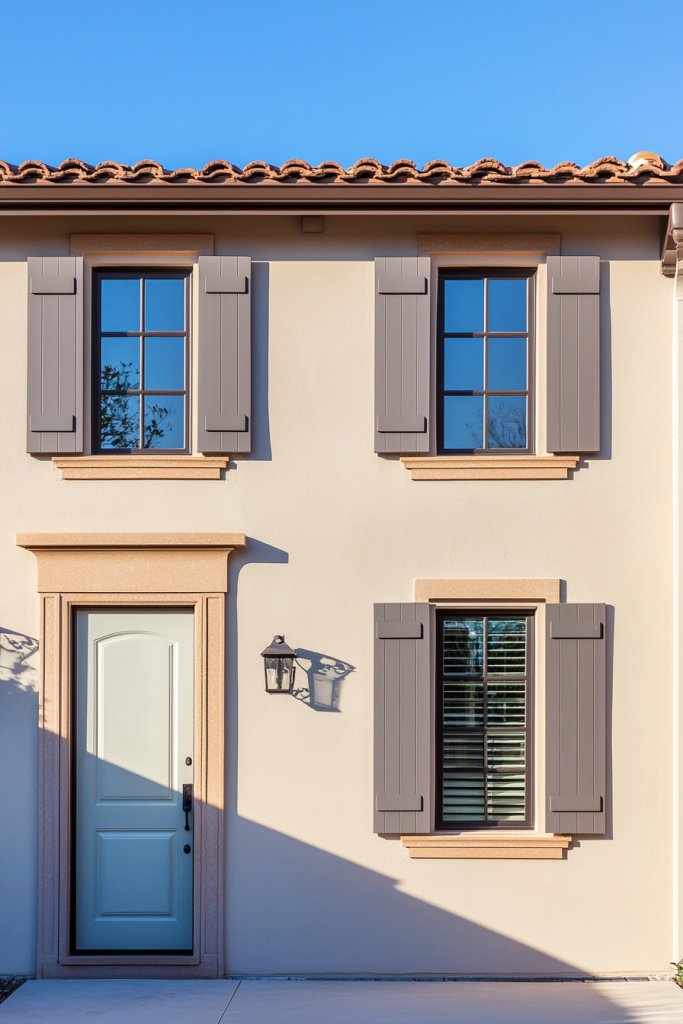
A harmonious color scheme for your external details—such as doors, window frames, trim, and accessories—can tie all elements of your front elevation together, creating a polished and inviting look. When colors complement each other, the overall aesthetic feels cohesive and balanced, enhancing curb appeal and making your home stand out in a subtle, tasteful way.
Envision a house with a soft, neutral exterior—like light beige or dove gray—paired with darker accents such as navy blue shutters, charcoal window frames, or a deep red front door. These contrasting yet harmonious hues highlight architectural features without overwhelming the senses.
Accents like house numbers, mailboxes, and porch furniture can be painted in warm metallics like brass or copper to add a touch of sophistication and warmth. The key is choosing a palette that reflects your personal style while maintaining visual harmony across all details.
To implement, start by selecting a base exterior color that complements your surroundings and personal taste. Use a color wheel for guidance—opposite or adjacent colors tend to work well together.
Then, choose accent colors for trim, doors, and hardware that create contrast and interest. Consider testing paint samples in different lighting conditions before committing to ensure the colors harmonize throughout the day. Finishing touches like matching planters or cushions in similar hues can further unify the look.
20. Adding Large, Inviting Windows with Stylish Shutters
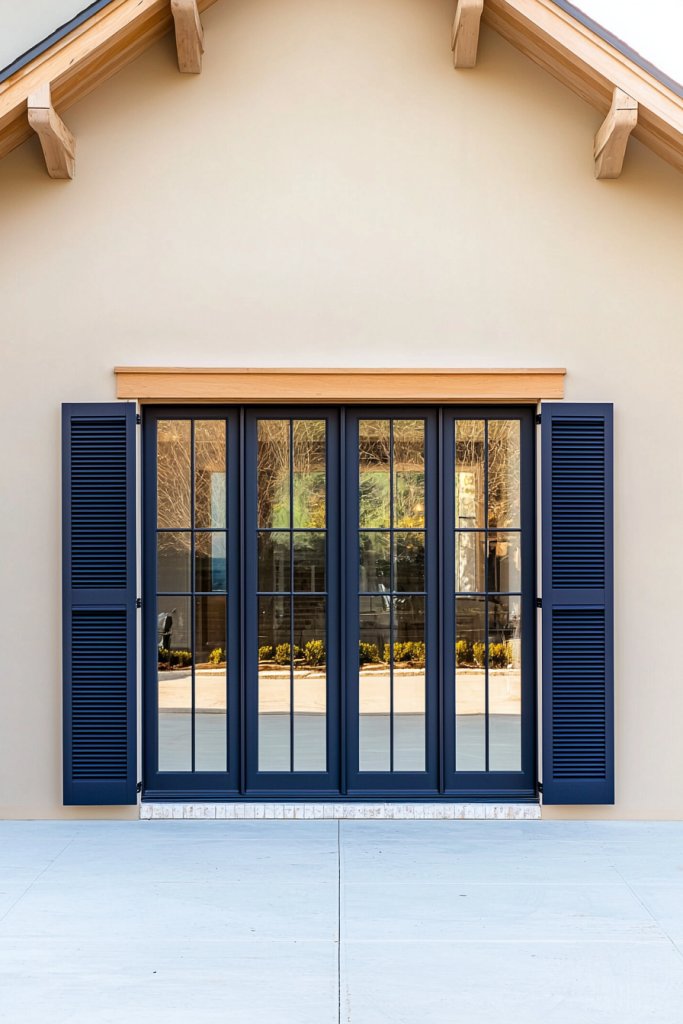
Large windows with stylish shutters instantly make your home appear more open, bright, and welcoming. They allow ample natural light to flood the interior, creating a warm and cheerful atmosphere that spills out onto the front elevation.
Decorative shutters add architectural charm and a touch of vintage or contemporary character, depending on the style chosen. Visualize expansive, clear-glass windows framed by bold, symmetrical shutters in a contrasting color—such as white shutters on a navy blue house—that frame the view beautifully.
The shutters can be louvered for a classic look or panel style for a more modern vibe. When open, they reveal inviting glimpses of your interior decor, while closed shutters add visual interest and privacy.
This combination creates a lively, dynamic facade that feels both cozy and stylish. To implement, select large, energy-efficient windows that suit your home’s style—consider vinyl, wood, or composite frames.
Pair them with decorative shutters made from durable materials like PVC, wood, or fiberboard, which can be painted or stained to match your color scheme. Mount shutters securely with weatherproof hinges, and consider operable shutters for added functionality. This simple upgrade not only enhances curb appeal but also improves light control and privacy, making your home more inviting every day.
21. Incorporating Statement Lighting Fixtures Near the Entrance
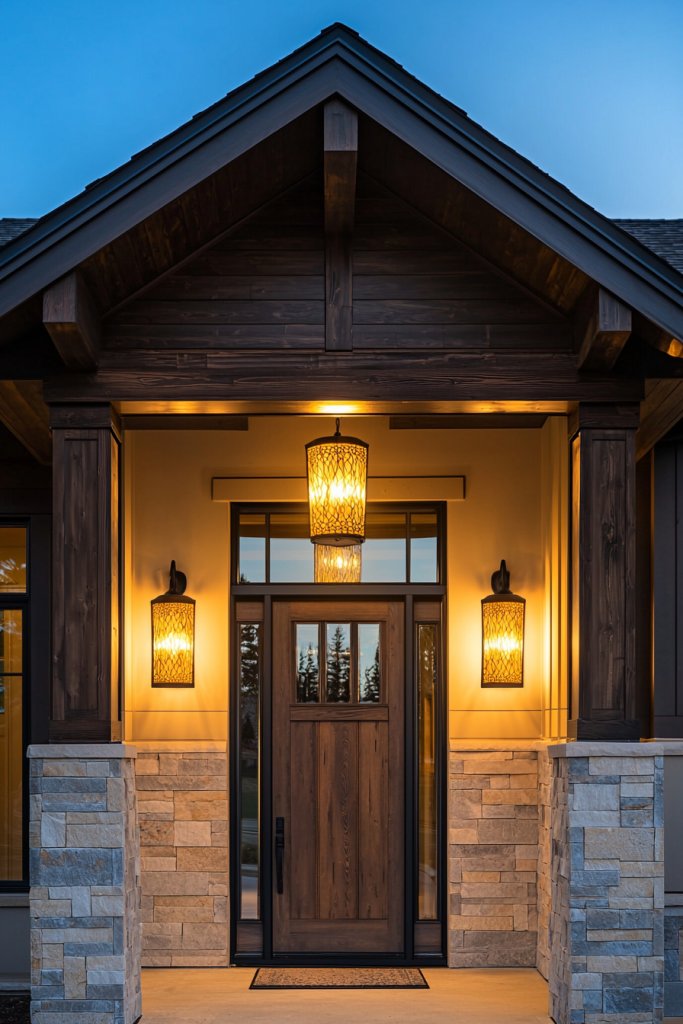
A bold lighting fixture can instantly elevate your home’s curb appeal while creating a warm, inviting glow that welcomes guests. Well-chosen statement lights act as both functional and decorative elements, making your front entrance memorable and stylish.
Imagine a large, vintage-inspired lantern with intricate metalwork, finished in matte black or brushed brass, casting a soft, ambient light over the doorway. Alternatively, a sleek, modern chandelier or cluster of pendant lights with unique shapes and warm-toned bulbs can add a touch of sophistication.
The fixture’s size and design should complement the scale of your entrance, and warm light temperatures (around 2700K) create a cozy, inviting atmosphere. The glow highlights architectural features and adds depth to the facade, especially during evening hours.
To implement this, start by selecting a fixture that matches your home’s style—be it rustic, modern, or transitional. Use a sturdy mounting bracket and ensure the electrical wiring is safely installed, preferably by a professional.
Use warm LED bulbs for energy efficiency and longevity. Position the fixture at eye level or slightly above the door to maximize impact.
If you’re unsure, consider a ready-made outdoor lighting kit with adjustable features. With a little planning, this statement piece will become a focal point that warmly greets everyone arriving home.
22. Using Textured or Patterned Exterior Tiles at the Entryway
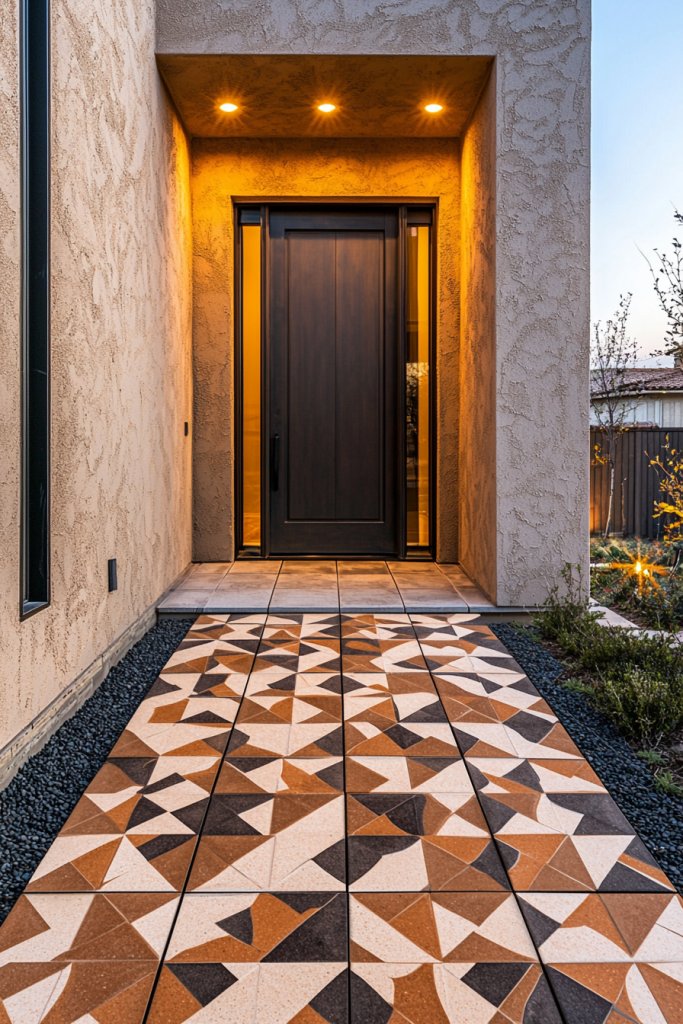
Textured or patterned exterior tiles instantly add visual interest and depth to your front entrance, making it a standout feature of your home’s facade. These tiles can transform a plain pathway into a stylish, welcoming pathway that reflects your personal aesthetic.
Picture a pathway lined with terracotta or encaustic cement tiles featuring intricate geometric or floral patterns. The tiles’ surface might have a matte, rough, or slightly embossed finish, providing tactile richness and reducing slip risk.
Choose colors like warm terracotta, deep blues, or soft neutrals that complement your exterior paint. The textured surface adds a sensory layer to the experience—your guests can feel the pattern underfoot as they approach the door, enhancing the welcoming vibe.
The patterned tiles also serve as a focal point, guiding visitors directly to the entrance and elevating the overall curb appeal. To create this look, select durable, weather-resistant tiles suitable for outdoor use, and measure your pathway carefully to order enough for the area.
For installation, ensure the surface is level and clean before laying the tiles with a high-quality outdoor adhesive. Seal the tiles with a weatherproof sealant to protect against moisture and stains.
If budget or space is limited, consider using patterned concrete overlays or interlocking pavers with textured surfaces. This simple upgrade offers a striking, personalized touch that lasts for years.
23. Incorporating Rustic or Vintage Elements for Charm
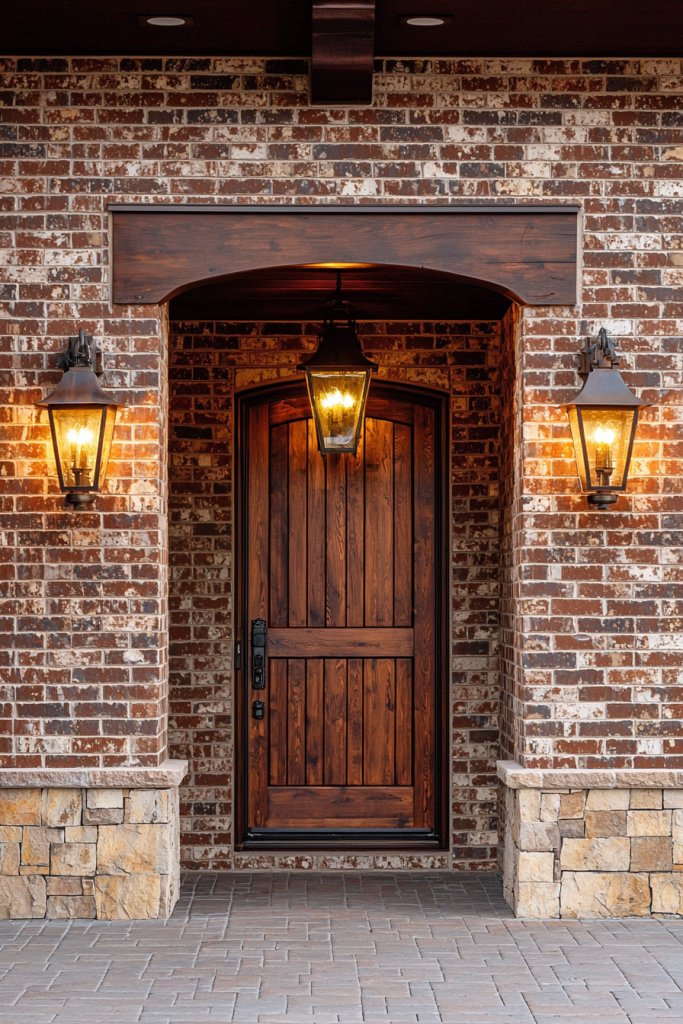
Adding rustic or vintage elements to your front elevation infuses charm and character, creating a warm, nostalgic atmosphere that invites visitors inside. These elements can range from weathered wood accents to vintage-style fixtures, all working together to craft an inviting exterior.
Visualize a reclaimed wood porch railing with a weathered patina, paired with vintage lanterns hanging beside the door. Or imagine a classic, distressed door painted in a soft pastel hue, complemented by antique brass hardware.
Incorporate vintage ceramic planters or wrought-iron details to enhance the old-world charm. These elements evoke a sense of history and craftsmanship, making your home feel cozy and lived-in.
The mix of textures—rough wood, aged metal, and chipped paint—adds warmth and visual depth, perfect for creating an inviting first impression. To incorporate rustic or vintage charm, start with affordable, weathered wood or repurposed materials available at salvage yards or DIY stores.
Use vintage-style lanterns or antique hardware for the door. You can also add decorative elements like a vintage mailbox or a distressed sign with your house number.
When installing, ensure all fixtures are securely mounted, and consider weatherproofing exposed wood and metal components. This approach is budget-friendly and highly customizable, allowing you to craft a charming, timeless facade that welcomes guests with warmth and personality.
24. Creating a Defined Entry Area with a Border or Low Wall
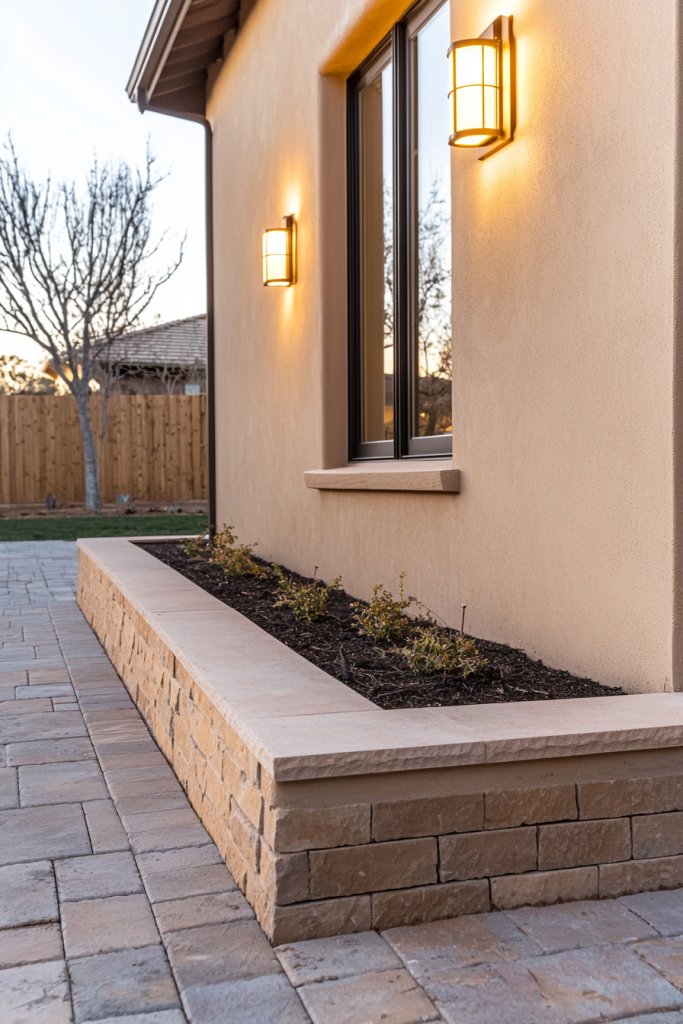
A clearly defined entry area with a border or low wall creates a sense of arrival, adds architectural interest, and helps organize your front yard. It visually separates the pathway from the rest of the landscape, making your entrance more inviting and structured.
Imagine a low brick or stone wall, about 2-3 feet high, running along each side of the pathway, topped with matching caps or decorative tiles. Alternatively, a border of neatly trimmed hedges or flowering shrubs can frame your entrance softly while providing a natural boundary.
These elements help direct visitors’ attention toward the front door and create a cozy, intimate space. The border can be further enhanced with built-in lighting, pathway edging, or decorative gravel inside the border for added texture.
Such features also contribute to curb appeal by giving your home a polished, finished look. To implement, choose materials that complement your home’s exterior—brick, stone, or treated wood are popular options.
Measure and plan your border or wall to suit your yard’s proportions, and consider DIY-friendly materials like modular paver blocks or pre-made low walls. Ensure proper foundation work for stability, and add an outdoor sealant or paint for durability.
Plant low-maintenance, weather-resistant plants in the border to soften the edges and introduce seasonal color. This simple addition creates a welcoming, well-defined entry that feels both elegant and approachable.
25. Embellishing the Front Facade with Artistic Architectural Accents
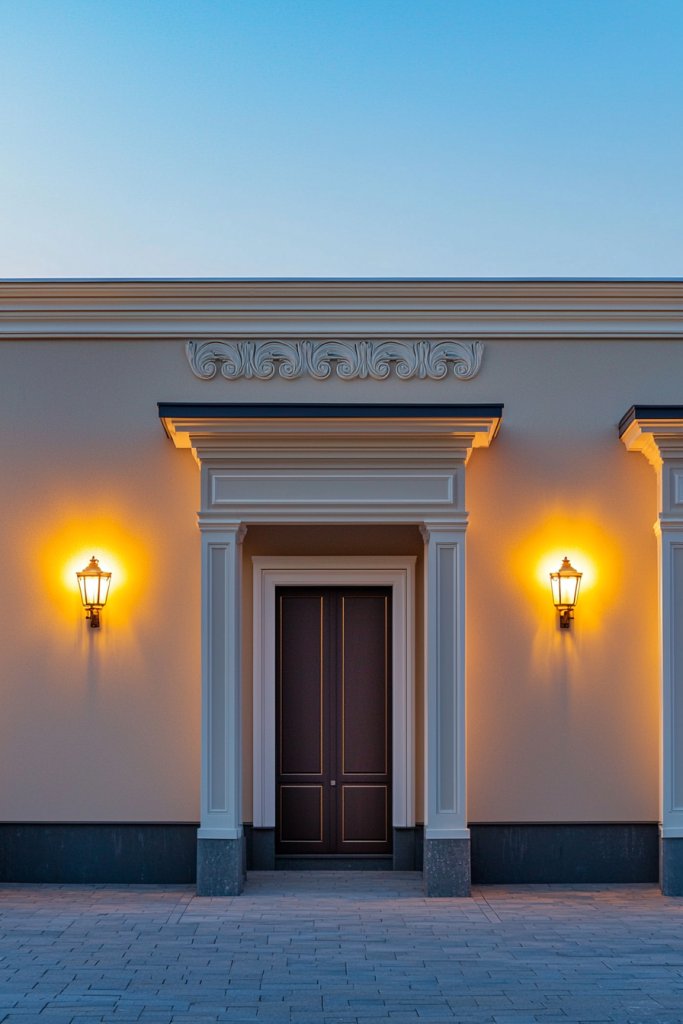
Artistic architectural accents turn a standard single-floor facade into a distinctive, eye-catching masterpiece. These accents add personality, elegance, and a touch of craftsmanship that elevates your entire home’s curb appeal.
Visualize decorative corbels under the eaves, ornate window surrounds, or a custom-designed front porch arch with intricate detailing. You might also incorporate textured stucco, decorative moldings, or even custom metalwork around the entrance.
These elements create visual interest through layered textures and shapes, drawing the eye upward and framing the front door beautifully. Using contrasting colors or materials—like dark trim against a light wall—further emphasizes these accents, making them stand out as focal points.
The overall effect is a facade that exudes personality and artistic flair, leaving a memorable impression. To achieve this, select architectural accents that align with your home’s style—classic, modern, or eclectic.
Use durable materials like fiber cement, carved wood, or metal for longevity. Installation may involve some basic carpentry or masonry skills, but many elements can be DIY with proper tools and guidance.
Focus on key areas like window trims, door surrounds, or porch beams, and consider painting or finishing these accents in a contrasting color to enhance their visual impact. This approach allows you to personalize your home’s exterior with artistic details that showcase craftsmanship and taste, making your front elevation truly one of a kind.
Conclusion
Transforming your single-floor front elevation with warm paints, inviting porches, charming pathways, stylish lighting, and natural accents can create an irresistible curb appeal that welcomes everyone with open arms. Whether you prefer classic elegance or rustic charm, these ideas offer versatile options to personalize your home’s entrance.
Don’t hesitate to experiment and blend these elements to craft a warm, inviting facade that truly reflects your style. Start today and turn your front yard into a beautiful, welcoming masterpiece!
Leave a Reply